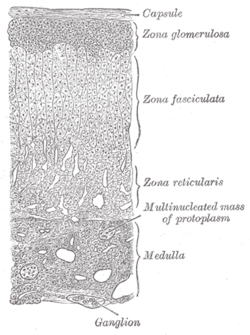Glucocorticoids
Adrenal cortex[edit | edit source]
The adrenal cortex composes the outer layer of the adrenal gland and consists of three sublayers called zonae each of which produces structurally similar and functionally different compounds and hormones. The cortical zonae are the zona glomerulosa, fasciculata and reticularis producing and secreting minerocorticoids, glucocorticoids and steroid hormones respectively.
- Zona Glomerulosa: is the outermost layer of the cortex specialized in the production and secretion of minerocorticoids and predominantly aldosterone a hormone involved in extracellular fluid volume and osmolality control. Aldosterone is generally responsible for the renal absorption of Na+ and exceretion of K+ from the distal part of the distal convoluted tubule and collecting duct and intestinal absorption of Na+ in lesser extend.
- Zona Fasciculata: is the intermediate layer of the cortex specialized in the production and secretion of glucocorticoids and predominantly cortisol and cosrticosterone hormones involved in metabolism control along with inflammatory regulation being of vital importance for life maintenance.
- Zona Reticularis: is the innermost layer of the cortex specialized in the production and secretion of sex steroid hormones and predominantly androgens and androgen precursors. The zona reticularis secretes androstenedione, dehydroepiandrosterone and dehydroepiandrostenedione which are not effective androgens as testosterone. However, when secreted they are transported to the gonads either testes or ovaries where they are converted to the more potent testosterone and to the most potent sex steroid hormone called dihydrotestosterone. The androgens stimulate and control the development and maintenance of male characteristics (and of female characteristics to lesser extend). This includes the activity of the accessory male sex organs and development of male secondary sex characteristics.
Glucocorticoids[edit | edit source]
The adrenocortical hormones are the compounds secreted by the adrenal gland except catecholamines. Therefore the adrenocortical hormones refer to glucocorticoids-cortisol, minerocorticoids-aldosterone and sex steroids-andogens. Precursor of all adrenocortical hormones is cholesterol.
Characteristiscs of glucocorticoids:[edit | edit source]
Glucocorticoids are the hormones secreted by the zona fasciculata of the adrenal cortex. The most abundant glucocorticoid is cortisol. Cortisol is an essential hormone for the human body, for example, bilateral removal of the adrenal glands eventually causes death, thus the patient must be administered cortisol for the rest of the life in order to sustain life. Cortisol is not stored in the adrenocortical cell to any significant extent, so a need for high amount of hormone requires rapid activation of the entire synthetic mechanism from cholesterol. Cortisol is transported in blood bound to a carrier protein called transcortin. Cortisol secretion exhibits distinct diurnal variation with a peak in the morning and minimum during sleep.
Function of cortisol:[edit | edit source]
1.Metabolic activity
- Cortisol promotes mobilization of protein in order to provide amino acids for gluconeogenesis critical for the survival of a fasting body. This is achieved primarily through acceleration of protein degradation and inhibiting of protein synthesis. During hypoglycemia the initial response to increase the glycemia is promoted by glucagon, thyroxin and epinephrine and later by cortisol.
- Cortisol has a weak lipolytic effect promoting mobilization of fatty acids and glycerol during fasting conditions in order to enhance the formation of energy through β oxidation and gluconeogenesis from fats.
2.Antiinflammatory activity
- inhibition of the recruitment of circulating leukocytes to the site of trauma or infection
- inhibition of differentiation and proliferation of local inflammatory basophils and mast cells
- decrease of the number of T cells with subsequent inhibition of the cell-mediated immunity
- decrease of phagocytic and bacteriocidal activity of neutrophils and probably macrophages
- reduction of local release of proteolytic enzymes
Regulation of the glucocorticoid secretion[edit | edit source]
- The secretion of adrenocortical hormones and specifically that of glucocorticoids and sex steroids is controlled by the hypothalamus whereas regulation of aldosterone release is under the control of the extracellular fluid volume regulation and Na+ balance.
- The paraventricular nuclei of the hypothalamus produce and secrete CRH (corticotropin releasing hormone)
- CRH enters the primary hypophyseal capillary bed at the median eminence and enters the secondary hypophyseal capillary bed
- CRH reaches the anterior pituitary lobe and acts on specialized cells called corticotrophs.
- Stimulation of the corticotrophs induces production and secretion of ACTH (adrenocorticotropic hormone)
- ACTH enters the secondary hypophyseal capillary bed and reaches the blood circulation
- ACTH acts in an endocrine fashion reaching the adrenal cortex affecting the secretory status of the adrenocortical cell
Links[edit | edit source]
Bibliography[edit | edit source]
- HALL, John E. – GUYTON, Arthur C. Guyton and Hall Textbook of Medical Physiology. 12. edition. Saunders/Elsevier, 2010. ISBN 1416045740.
- Lecture Notes: Prof. MUDr. Jaroslav Pokorný DrSc.



